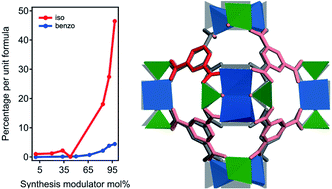Effect of modulator connectivity on promoting defectivity in titanium–organic frameworks†
Abstract
The recognition of defect chemistry as a true synthetic tool for targeted creation of defects and controllable performance remains limited by the pool of frameworks explored. The value of defect engineering in controlling the properties of defective frameworks has been beautifully exemplified and largely demonstrated with UiO-type materials based on Zr(IV) nodes. However, titanium–organic frameworks remain largely unexplored in this context arguably due to the complex chemistry in solution of Ti(IV) and the difficulties in growing crystalline solids. We report a systematic study on the ability of mono- and dicarboxylic modulators (benzoic and isophthalic acid) to promote defect creation in the heterometallic Ti-MOF of the MUV-10 family. Our results indicate that both acids behave as capping modulators at high concentrations, but isophthalic acid is a more efficient defect promoter, yielding defective phases with nearly 40% of missing linkers. Our computational results suggest that this difference cannot be solely ascribed to relative changes in acidity but to the ability of this bidentate linker in compensating the structural distortion and energy penalty imposed by breaking the connectivity of the underlying framework.



 Please wait while we load your content...
Please wait while we load your content...